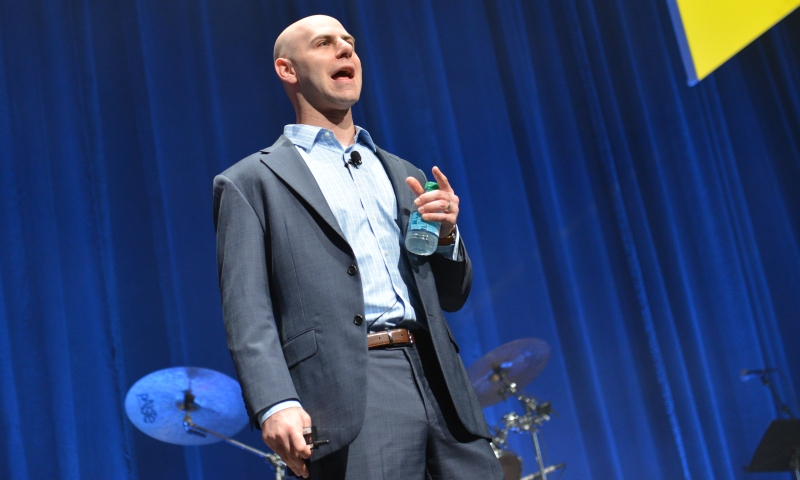
Let Your Givers Grow
Author Adam Grant tells associations to foster a giving culture by rewarding helping and sharing in the workplace and giving the selfish the heave-ho.
Kicking off the 2014 ASAE Annual Meeting & Exposition Sunday, author Adam Grant tells associations to foster a giving culture by rewarding helping and sharing in the workplace and giving the selfish the heave-ho.
If you ask Adam Grant, one of the most famous mantras in management—”get the right people on the bus”—is good advice, but not quite great.
Instead, Grant, professor at the University of Pennsylvania’s Wharton School of Business and author of Give and Take: Why Helping Others Drives Our Success, would urge organizations to focus on keeping the wrong people off the bus. Why? Because his research into work styles has shown that just a few bad apples can indeed spoil the bunch.
In an environment free of takers, givers can become more generous because they don’t have to protect themselves from being stepped on by takers looking to get ahead.
Grant classifies people into one of three personality styles: givers, takers, and matchers. Givers are helpful, selfless, and sharing; takers are the opposite, and matchers believe in quid pro quo. The more givers in an organization, the better it performs, but the problem is that givers grow cautious when takers lurk. In fact, “the most common kind of taker is someone who used to be a giver or a matcher but got burned too many times,” Grant told attendees at the opening general session of the 2014 ASAE Annual Meeting & Exposition in Nashville on Sunday.
And so, in an environment free of takers, givers can become more generous because they don’t have to protect themselves from being stepped on by takers looking to get ahead, Grant says. Moreover, matchers, no longer needing to worry about keeping takers in check, tend to become givers.
Grant says this is all especially pertinent in the world of associations, which thrive on collaboration and the power of members connecting and helping each other, and where a culture of giving must be cultivated both on staff and among volunteers.
Grant’s research into giving and taking revealed surprising results, he says. For instance, givers are disproportionately represented among both low and high performers. “I think that’s fascinating paradox, that good guys and gals are more likely to finish last and more likely to excel,” he says.
“Givers end up with better reputations and relationships than takers and matchers, which is a long-term advantage,” Grant says. “But some givers don’t know how to manage this,” and they get taken advantage of.
To foster a giving culture at your association, Grant offers five steps:
1. Get the right people on the bus, and the wrong people off. Here Grant recommends screening out takers. How? Seek lateral and downward references, such as a candidate’s past same-level colleagues or subordinates. Takers spend their energy trying to impress those with influence, meaning a taker’s boss likely doesn’t know the taker’s true nature and isn’t a useful reference.
He also suggests asking questions about what a job candidate thinks other people would do in certain situations. For instance, research shows that people who estimate a high percentage of employees steal from their companies are more likely to be thieves themselves. “You can learn a lot about people by asking them to forecast what they think other people would do,” Grant says.
2. Redefine giving. You don’t have to be a saint to be an effective giver, Grant says. Some of the best giving can happen in what he calls “five-minute favors,” in which a simple act delivers high benefit to another person with little cost to the giver. Making an introduction between two people who could collaborate is a great example, he says.
3. Change reward systems. Grant encourages association leaders to ask themselves, “How can I evaluate people not just on what they achieve but on how they contribute to other people’s accomplishments?” Metrics that measure team performance or support of colleagues can incentivize giving.
4. Encourage help-seeking. “There’s no way for people to give if they don’t know who needs help,” Grant says. Leaders should model this behavior themselves, asking for help from colleagues to show that giving is to be encouraged. One of the biggest differences between givers who are high performers and those who are low performers is their willingness to ask for help, Grant says.
5. Build “reciprocity rings.” A group of eight to 10 people brought together to help each other can be simple but powerful, Grant says. Each person should be required to bring a problem they can’t solve on their own. When everyone asks for help, everyone becomes comfortable with offering help, as well, he says.
(photo by Khaaliq Thomas)






Comments